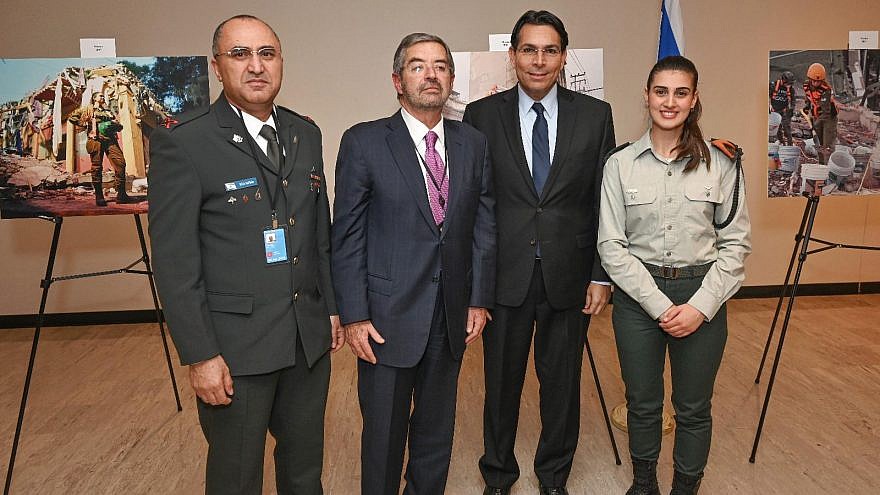An exhibit accessible for one week at the United Nations headquarters in New York City highlighted Israel’s humanitarian-aid efforts across the globe.
Organized by the Israeli Mission to the United Nations, “Israel’s Humanitarian Aid Around the World” opened on March 25 and wrapped up on March 29. It featured 18 photographs showing soldiers from the Israel Defense Forces and Israeli volunteers aiding those affected by natural disasters, requiring medical care and more in Haiti, Nepal, the Philippines, Mexico, Brazil, Syria, Liberia, South Sudan and North Mauritania. The pictures were accompanied by brief descriptions outlining Israel’s work in each location.
“I just came back from the Security Council, where the Syrian ambassador accused us of committing war crimes,” he said. “And I think if he walked through this room and saw what we’re actually doing to help Syrians, he would’ve changed his mind.” When asked if he thinks Israel gets enough recognition at the world body for its humanitarian efforts, he replied, “The U.N. is a daily war; it’s not a boxing match. So we have to continue every day exposing the real face of Israel.”

John Kemp, 65, a visitor to the exhibit, said after looking at the photos on Wednesday, “they show a lot of interaction, Israel’s heart. I really see them touching people.”
He added that he was excited to come to the exhibition and see the Jewish state portrayed in a positive light, saying, “I know that I don’t get the news as I’d like to, and to hear positive things about Israel, so I wanted to get it firsthand.”
“It’s really special to see how the government and the IDF send people all over the world to take care of people in need, and they’re really the first ones there often, and I think that’s incredible and admirable,” said Jordana Leibowitz, 23. “It’s incredible to see the pictures here and learn a bit about it, especially with nations that are right next to Israel, like Syria. They actually have a non-aligned state status at this point, Syria and Israel, so the fact that they’re sending aid there really shows them going above and beyond to take care of people in need.”
Brig. Gen. Dr. Tarif Bader, surgeon general of the IDF, spoke at a ceremony for the exhibit on Wednesday about Israel’s longest humanitarian mission: helping wounded Syrian civilians, its “Good Neighbor” policy. Bader called it a “very unique mission [of] extending a helping hand for our neighbors, or as they call us, their enemies.” For almost five years, from February 2013 until last August, Israel treated more than 4,500 injured Syrians at the border, he said.
“Nobody can cope with these disasters alone, and I hope [the] message from this place is that we have to collaborate,” he said. “We have to share the knowledge, we have to share the experience, we have to share the abilities that we have. This is what the State of Israel is doing. Whenever there’s a need, we are there.”
Other countries can learn from Israel’s rapid response
Mexico’s Ambassador to the United Nations Juan Ramón de la Fuente spoke about Israel’s work in helping Mexico in the aftermath of two consecutive earthquakes that shook the country in September 2017, killing 469 people and leaving 250,000 homeless, according to the ambassador. Israel’s delegation was one of the first to arrive at the scene of the disaster and provide assistance.
De la Fuente told JNS that the exhibit shows the importance of strengthening relations and collaborations between countries. He said, “We’re here to say that our experience shows that solidarity of countries—in this case, of Israel with Mexico—was important. It did help us, and we thank you for that. … I’m here to give them credit they deserve for what they did when they helped us in Mexico.”
The ambassador commended the Jewish state for its quick response when humanitarian aid is needed. He noted that other countries can “absolutely” learn from Israel’s rapid reaction time and its ability to be on site, build field hospitals and have the necessary human resources and infrastructure in place mere hours after a natural disaster occurs around the world.
He also called onto the United Nations not to “lose perspective” and be vigilant in promoting strengthened collaborations and better protocols for times of natural disasters so countries that need the assistance can get it more quickly.
During his speech, de la Fuente said 25 countries sent aid to help Mexico following the earthquakes in 2017, but “we acknowledge with our deepest gratitude to the one that came from Israel. The support we received from Israel stands out for different reasons.”

He discussed Israel’s coordinated efforts to send food, mattresses and blankets to those affected, and Israeli Prime Minister Benjamin Netanyahu’s visit to Mexico following the first earthquake—the first-ever visit to the country by a head of the Israeli government to Israel. Following the second earthquake, Netanyahu ordered a team of 72 engineers, rescuers and experts to visit the affected areas and provide assistance, according to the ambassador.
“Thank you again for your solidarity, your efficient help, and most of all, for your friendship,” he said.
“We all have a collective responsibility to act when it comes to humanitarian aid,” explained Danon at the conclusion of the event. “Israel acts; we take action. For Israel, human life will always take priority over politics. Jewish tradition teaches that when you save a life, it’s as if you have saved an entire universe. Despite years of provocation and rocket attacks, Israel is always the first to arrive when human life is involved.
“Crisis and tragedy do not discriminate, so neither can we,” affirmed Danon. “Let us protect life by any means necessary, and together build a stronger and more caring world.”


























